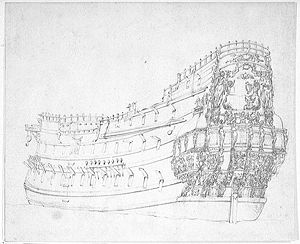 Portrait of Victory by Willem van de Velde the Elder, 1655
| |
| History | |
|---|---|
| Name | Victory |
| Ordered | 10 March 1620 |
| Builder | William Burrell, Deptford Dockyard |
| Launched | 1620 |
| Commissioned | 1627 |
| Fate | Broken up, 1691 |
| Notes | |
| General characteristics as built[1] | |
| Class and type | 42-gun great ship |
| Tons burthen | 87079⁄94 bm |
| Length | 108 ft 0 in (32.92 m) (keel) |
| Beam | 35 ft 9 in (10.90 m) , later raised (probably through girdling) to 37 ft 6 in (11.43 m) |
| Depth of hold | 17 ft 0 in (5.18 m) |
| Sail plan | Full-rigged ship |
| Complement | 260–300 |
| Armament | 42 guns |
| General characteristics after 1666 rebuild[2] | |
| Class and type | 82-gun second-rate ship of the line |
| Tons burthen | 1029 74⁄94 bm |
| Length | 121 ft (37 m) (keel) |
| Beam | 40 ft (12 m) |
| Depth of hold | 17 ft 6 in (5.33 m) |
| Sail plan | Full-rigged ship |
| Armament | 82 guns of various weights of shot |
Victory was a great ship of the English Navy, launched in 1620 and in active service during the seventeenth century's Anglo-Dutch Wars. After a seventy-year naval career, she was broken up at Woolwich Dockyard in 1691 and her timbers reused in other vessels.